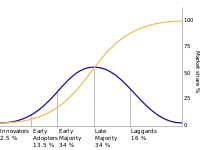
Photo from wikipedia
Network diffusion processes or how information spreads through networks have been widely examined in numerous disciplines such as epidemiology, physics, sociology, politics, or computer science. In this paper, we extend… Click to show full abstract
Network diffusion processes or how information spreads through networks have been widely examined in numerous disciplines such as epidemiology, physics, sociology, politics, or computer science. In this paper, we extend previous developments by considering a generalization of the diffusion by considering the possibility of differences in the speed of diffusion and reduction depending on the forces’ directions. In this situation, the differential speed of diffusion produces deviations from the standard solution around the average of the initial conditions in the network. In fact, this asymmetry gives rise to non-linear dynamics in which, contrary to the symmetric case, the final solution depends on the topology of the graph as well as on the distribution of the initial values. Counter-intuitively, less central nodes in the network are able to exert a higher influence on the final solution. This behavior applies also for different simulated networks such as random, small-world, and scale-free. We show an example of this kind of asymmetric diffusion process in a real case. To do so, we use a network of US Boards of Directors, where boards are the nodes and the directors working for more than one board, are the links. Changes in the proportion of women serving on each board are influenced by the gradient between adjacent boards. We also show that there is an asymmetry: the gradient is reduced at a slower (faster) rhythm if the board has less (more) women than neighboring boards. We are able to quantify the accumulated effect of this asymmetry from 2000 to 2015 in the overall proportion of women on boards, in a 4.7 percentage points (the proportion should have been an 14.61% instead of the observed 9.93% in 2015).
Journal Title: PLOS ONE
Year Published: 2022
Link to full text (if available)
Share on Social Media: Sign Up to like & get
recommendations!